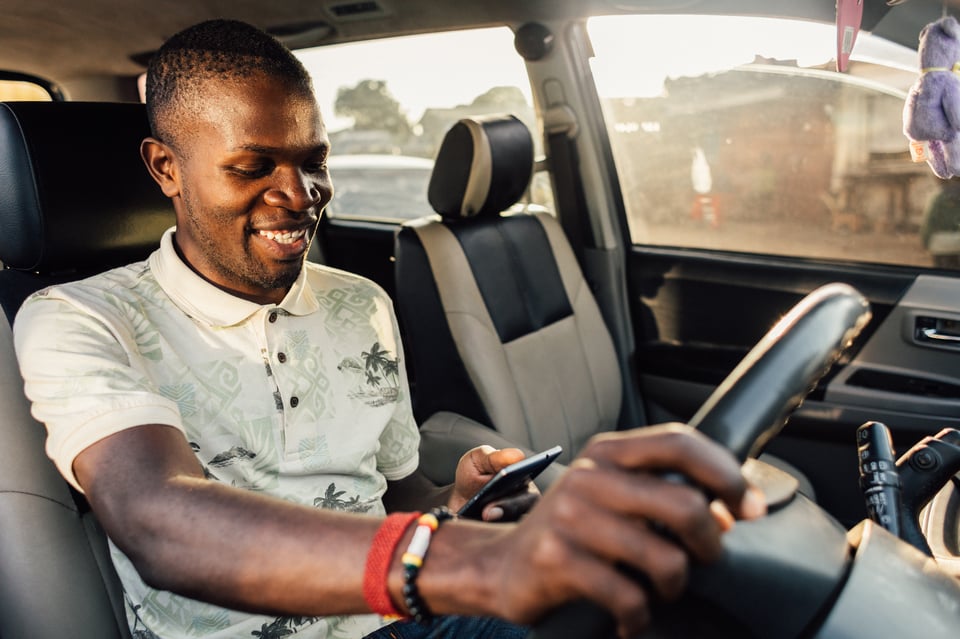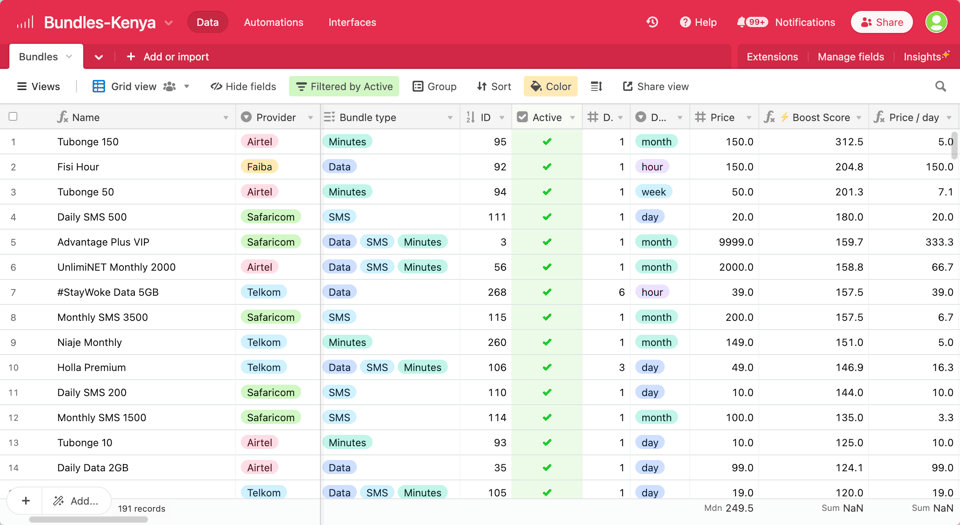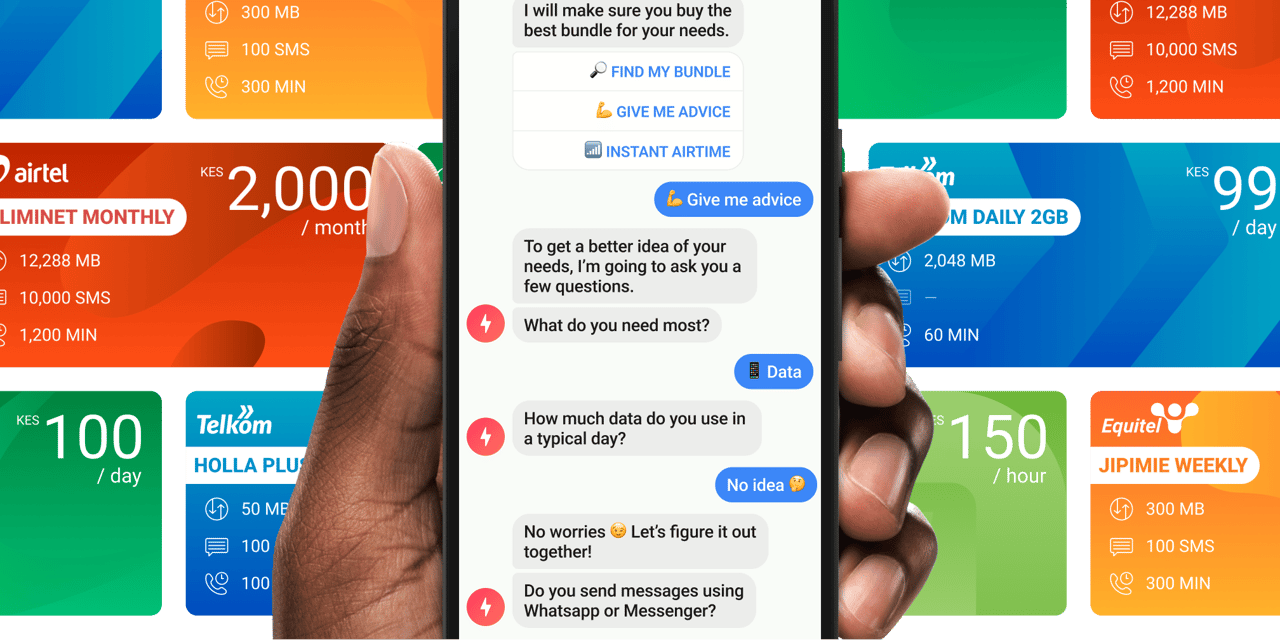Boost
The Boost chatbot was the first phone subscription comparison service in Kenya. Ranking and reviewing over 200 different plans across 5 mobile network providers, Boost made it easy for thousands of Kenyans to get the most value for the lowest price.
The Origins
Boost was born from the simple realisation that in Kenya in 2018 there were more than 200 different bundles available. A bundle is a combination of calling minutes, SMS messages and mobile data. But why so many bundles?
Kenya's telecommunications landscape is different from what you might be used to. Most subscribers buy prepaid bundles. These are bought up front, and give you an allowance that you can use within a specific duration. Unlike in most other countries, in Kenya the most common duration is not a month, but a day.
Daily bundles are popular for a simple reason: they match the income patterns of the country.

This Uber driver for example gets paid after each ride, and uses that income to rent the car and buy the data needed to run their business for the next day. An estimated 83% of the active population works like this, in the informal economy. They make a living by trading and providing services. They don't have a monthly paycheck, but instead hustle on a day to day basis.
The combination of different durations, different networks and different allowances creates an offering that is very varied and where the value can be wildly different.
Enter Boost
Telecommunications are a big chunk of a person's expenses in Kenya, averaging 10$ per month on a monthly income of 150$.
Scan to watch this video
The goal with Boost was to bring that cost down by 20%, simply by highlighting better bundles. And to do so, we built a Facebook Messenger chatbot that can guide users to the best bundles for their usage.
The chatbot asked users about their consumption patterns, and then suggested bundles offering the best value for their requirements.
But simply listing specifications wasn't enough. Bundles often had a hidden terms and conditions that the numbers themselves didn't reflect. So we wrote in-depth reviews for each and every bundle for sale in Kenya. We gave instructions on how to purchase some of the less marketed plans. And we made it easy for customers to buy bundles directly from our chatbot.
Boost made revenue through bundle purchases. We bought bundles in bulk at a discount, and resold them at face value, straight from Facebook Messenger. We also built a rewards program incentivising repeat purchases, which could be exchanged for even more bundles.
Powered by Airtable
To keep track of all the bundles and plans, we made heady use of Airtable.

Airtable is a user-friendly and powerful mix of a database and an Excel document. It allowed us to standardize all the bundles on the market, and enabled us to automatically assign a "Boost score" that reflected the value to users.
This Boost Score was then used to rank the various bundles, allowing us to surface the best ones. But an algorithmic approach is not always the best. That's why we made the decision to painstakingly review every single bundle. And if it turned out a bundle had more or less value than the Boost Score suggested, we had levers to influence the score.
The other big advantage of using Airtable is that it exposes a REST API that our backend could consume. That made it extremely easy and fast to adapt to updated prices or new bundles.
Ultimately, Airtable became the source of truth for Boost, and was simple enough that copywriters could use it directly to update content.
An unexpected exit
While we managed to get over 3,000 people to search for and purchase bundles on Boost, we dind't see the necessary growth. In an attempt to stimulate growth, we were creating content to keep our customers engaged.
One piece of content focused on explaining to our customers what they can do with 1GB of data. How long can you watch YouTube? How many Instagram posts can you scroll through?
If we couldn't answer these question, how could anyone know what exactly to buy? We analyzed the data usage of popular social media apps, and wrote about our findings in a blog post.
Nobody read the blogpost.
But then I stumbled upon a new format: Web Stories. So I reformatted the blogpost as a Story. And sent that Story to all our users.
The results were incredible: the average time on the page shot up from a few seconds to over a minute! Over 70% of the people watched the story to the end. And the Story was even shared outside of our userbase.
People engaged with the story because it was designed for the device they were consuming content on. This ultimately led to the pivot of our company and the creation of Tappable, a design tool for Web Stories.
Scan to watch this video
If you want to know more about our pivot from Boost to Tappable Stories, I invite you to watch the talk our CEO gave at the AMP Conf in Japan.
Tech stack
These are the technologies I chose as CTO to build and launch Boost.
The Boost website was built in Vue + Nuxt. The backend was powered by the full Firebase platform. Our chatbot was powered by Chatfuel. Africa's Talking was the API provider that allowed us to integrate with mobile networks and mobile money providers.

Vue 2

Nuxt

Bulma

Javascript

Node.js

Firebase

Firebase Hosting

Realtime Database

Cloud Functions

Big Query

Airtable

Chatfuel

Africa's Talking

Web Stories
Vue 2 Nuxt Bulma Javascript Node.js Firebase Firebase Hosting Realtime Database Cloud Functions Big Query Airtable Chatfuel Africa's Talking Web Stories
Credits
A big thanks to the 6 people who worked on demystifying airtime bundles in Kenya!

Hans Pauwels
Founder & CEO

Charles-Axel Pauwels
Founder & CTO

Henri-Jérôme Pauwels
Founder & CMO

Ridge Kimani
Software Developer

Mark Smith
Video Editor

Christine van Wassenhove
Illustrator
Hans Pauwels · Founder & CEO
Charles-Axel Pauwels · Founder & CTO
Henri-Jérôme Pauwels · Founder & CMO
Ridge Kimani · Software Developer
Mark Smith · Video Editor
Christine van Wassenhove · Illustrator

